During the first two days of the invasion, November 20 and 21, the Marines making the long trip to the beach from Higgins boats grounded on the reef and those hunkered down behind the seawall were unpleasantly surprised to find they were being fired on not only from Betio's defenses but also from the lagoon to their rear. Most of the fire was coming from the rusting ship grounded off Red Beach 2, a couple hundred yards from the end of the pier. Many Marines who came ashore on Red Beach 2 mention taking fire from this ship.

Image taken from the lagoon facing south toward Betio from film footage that
was included in the USMC film, "With the Marines at Tarawa" possibly shot by Norm Hatch.This ship is often incorrectly refered to as the Niminoa in most secondary sources but is actually the Japanses ship Sadu Maru. The Niminoa was an inter-island steamer piloted by, Edward Harness, a British citizen living in the Gilbert Islands. After the Japanese invasion in 1941, he scuttled the Niminoa to prevent it from being commandered for Japanese use. Further damage to the ship was caused when the Japanese blew the boilers to prevent any europeans or New Zealanders from using it to escape the islands. Incidentaly a number of europeans and New Zealanders did escape using some boats they had hidden elsewhere on the atoll. (1) Some historians, like Martin Russ in his Line of Departure and more recently Michael Graham's Mantle of Heroism, have identified the ship as a Japanese frieghter, the Sada Maru, that was carrying construction material when it was hit and sunk on September 18, 1943 during a raid by Dauntless divebombers launched from the Princeton and Belleau Wood.(16)
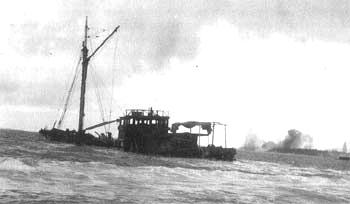
This image from Hammel's 76 Hours, is reportedly the Niminoa. The exact location is not pinpointed yet.
 The Niminoa Pre-War in all her glory.
The Niminoa Pre-War in all her glory.All during D-Day morning, November 20, heavy fire was reported coming from the Sadu Maru. Somehow the Rikusentai, Japanese Special Naval Landing Force troops, had managed to occupy the derelict hulk. Some amtracs and Higgins boats were recieving fire from the Sadu Maru even before they made it to the reef.(2) Around 0930 an LCVP, carrying 2nd Lt. Lawrence Vlach and his .30 machinegun platoon of H Co. 2/2, sought some refuge from the Japanese fire behind the Sadu Maru. During this manuever the boat's bow ramp became stuck on the fantail of the larger ship. While the coxswain attempted to free the craft, Vlach climbed up the bow ramp for a look into the Sadu Maru. He saw two Japanese rifleman and promptly cut them down with his M1 carbine. Three Japanese appeared and Vlach exchanged fire with them. All three of them were eliminated. The boat then suddenly lurched away from the Sadu Maru throwing the now wounded Vlach to the deck of the LCVP. Another LCVP was ordered in and raked the Sadu Maru with its machineguns.(3)
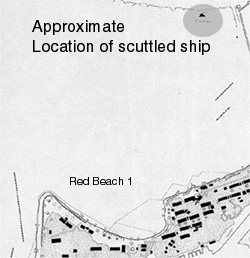
The ship might be further away from the pier then the map indicates.A naval gunfire mission was requested on D-day and the destroyer Ringgold responded. According to the ship's log the fire mission began at 1219, "At the request of of Marine officer, landing boat opened fire on a grounded hulk near the beach, western end of Betio Island, in the lagoon. Was informed hulk contained snipers. Hit on first salvo; hulk began to smoke. Fired 20 rounds." (4)
Alexander reports that Col. Shoup had thought that the Sadu Maru had been cleared by Marines had who had "crawled up the anchor chain during morning of D-day."(5) However, during D-Day night the Rikusentai in twos and threes slipped into the lagoon and waded out to man wrecked landing craft and the Sadu Maru. According to Alexander, the rusting hulk now contained several machine gun crews and plenty of ammunition. (6) In the official USMC training film, "MTF-S3 The Tarawa Operation", the Japanese were said to have occupied at least two amphibious tractors, one off Red Beach 2 and the other off Red Beach 3. .
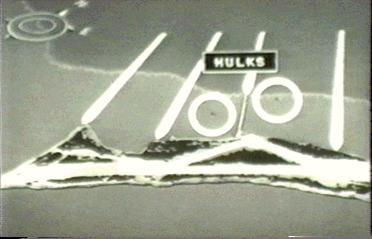
Shown here is the location of the Japanese occupied amphibious tractors disabled on the reef.In the morning of D+1 the Higgins boats containing the 1st Battalion 8th Marines hit the reef and began discharging the troops. Companies A and B were mauled as they waded across the reef. Fire came from the Pocket on Red Beach 1, from the Japanese occupied disabled amtracs, and from the Sadu Maru despite the shelling and even bombing on D-Day. (7)
Lt. Eddie Heimberger, also known as Eddie Albert, was picking up the wounded Marines in a LCVP and came under fire from the gunners in the Sadu Maru. His gunner poured .30 machine gun fire onto the steamer and also silenced a sniper in a wrecked LVT that was also killing Marines.(8)
Another landing craft was grounded just to West of the Sadu Maru that contained the mobile shore fire control party of 1/8. Although they were pinned down the .50 gunner kept up a steady stream of fire toward the ship until he was hit. Another member of the party, PFC Ted Jachiemowicz, lept up and continued pouring fire onto the ship while someone else called in fire from a jeep radio in the landing craft. (9)
From a different vantage point in the lagoon, Lt. Galen Brown saw an LCVP racing toward the Sadu Maru. Aboard were three .50 machine guns blazing away at the Japanese on the Sadu Maru. Balanced precariously on the bow ramp was a, "...Bluejacket having the time of his life firing a machine gun barehanded from the hip." (10)
Chaplain Wyeth Willard described the horiffic scene from his vantage point in a landing craft off Red Beach 2, "Fire from many enemy positions mowed them down as a scythe cuts through grass." According to Willard's account his boat landed about 100 yards to the right of the Sadu Maru. He could see two men, that he thought were Japanese, frantically waving their hands in an effort to persuade them to come over to wrecked ship. Willard later learned that these were Marines who had killed some of the Japanese inside.(11)
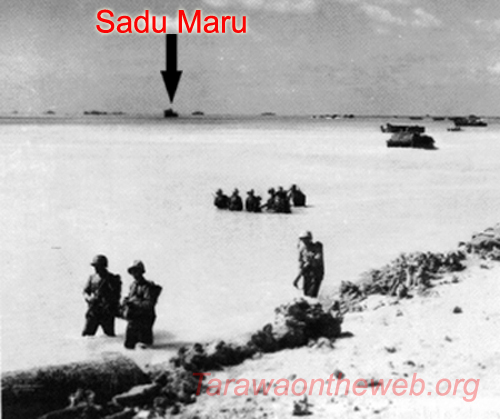
In many pictures taken from Red Beach 2 the Sadu Maru is clearly visible. From Red 2, Col. Shoup viewed the carnage inflicted on the 8th Marines and could take no more. He, "...grabbed a radio and called in aerial support and naval gunfire. He wanted the Sadu Maru blown apart."(12) Soon F4F wildcats began to bomb and strafe the Sadu Maru. Unfortunately the pilots were inconistent with their bombs. Out of 12 500lb bombs dropped, only one hit the ship squarely and one other attempt was approximately 200 yards off target. A number of Marines thought they were mistaken for Japanese and had been the target of the attack. At 0755, Col. Shoup halted the ineffective air attack, "Stop strafing! Bombing ship, hitting own troops."(13)
Col. Shoup then sent a group of Marines to clear the ship. They boarded the Sadu Maru from the aft, the blind side of the Japanese gunners which were still firing. After climbing to the third deck of the ship, the patrol found at least two machine guns and a large number of rifleman, "...well concealed behind the steel plating on the port side." The sargeant and the rest of the group moved out of earshot of the Japanese and radioed Col. Shoup with a report and a request for instructions. Shoup ordered them back to shore and requested naval gunfire on the Sadu Maru although with some reluctance since there was a chance of hitting friendly troops on the beach or even hitting the ever important pier. The Maryland and Colorado replied with an accurate barrage that left the steamer, "...a smoking, mangled, and silent heap of metal." (14)
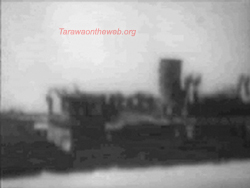
The bridge of the Sadu Maru probly shot from a passing Higgins
boat. Screenshot from "With The Marines at Tarawa."For the evening of November 21, the 1st Battalion, 10th Marines placed two of its 75mm pack howitzer sections on the beach to cover the Sadu Maru and any disabled landing craft that might be occupied by Japanese snipers to be on the safe side.(15) No other menbtions of small arms fire coming from the Sadu Maru after November 21 was reported.
More photos of the Sadu Maru exist taken by the Seabees after the fighting had ended. These pictures give a good idea of the size of the size of the Sadu Maru. As soon as these are secured they will be added to the article.
Foot Notes* 7. Hammel and Lane, MCG, p. 35.
9. Hammel and Lane, MCG, p. 36.
13. Wright, p. 84.; Alexander, p. 162.
14. Wright, p.84; These men could have been some that Chaplain Willard had seen near the Sadu Maru.
16. Graham p. 23.; also see Russ
*For the full citation please see the bibliography section.
